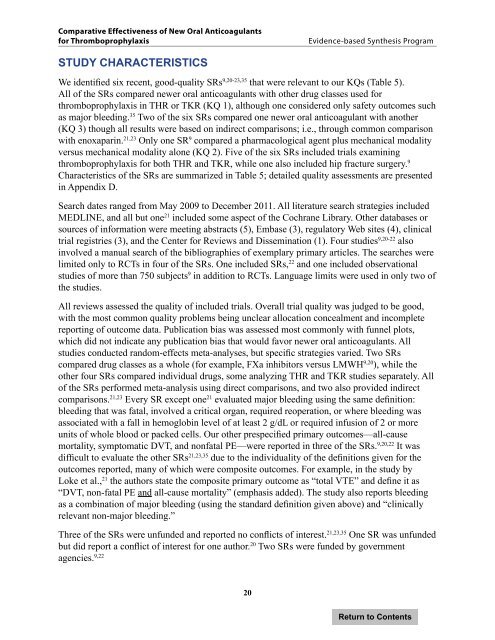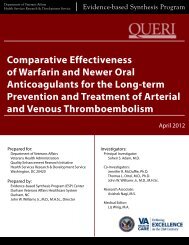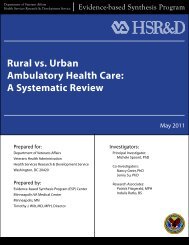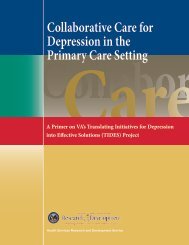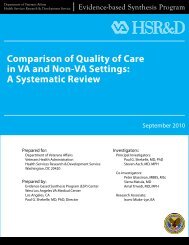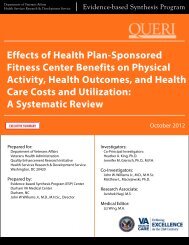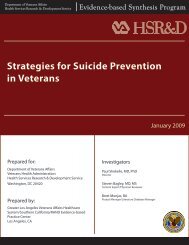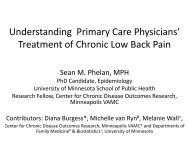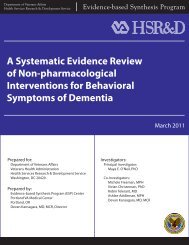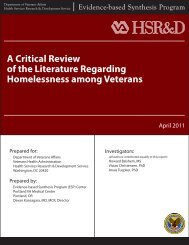Comparative Effectiveness of New Oral Anticoagulants for ...
Comparative Effectiveness of New Oral Anticoagulants for ...
Comparative Effectiveness of New Oral Anticoagulants for ...
Create successful ePaper yourself
Turn your PDF publications into a flip-book with our unique Google optimized e-Paper software.
<strong>Comparative</strong> <strong>Effectiveness</strong> <strong>of</strong> <strong>New</strong> <strong>Oral</strong> <strong>Anticoagulants</strong><br />
<strong>for</strong> Thromboprophylaxis<br />
Evidence-based Synthesis Program<br />
STUDY CHARACTERISTICS<br />
We identified six recent, good-quality SRs 9,20-23,35 that were relevant to our KQs (Table 5).<br />
All <strong>of</strong> the SRs compared newer oral anticoagulants with other drug classes used <strong>for</strong><br />
thromboprophylaxis in THR or TKR (KQ 1), although one considered only safety outcomes such<br />
as major bleeding. 35 Two <strong>of</strong> the six SRs compared one newer oral anticoagulant with another<br />
(KQ 3) though all results were based on indirect comparisons; i.e., through common comparison<br />
with enoxaparin. 21,23 Only one SR 9 compared a pharmacological agent plus mechanical modality<br />
versus mechanical modality alone (KQ 2). Five <strong>of</strong> the six SRs included trials examining<br />
thromboprophylaxis <strong>for</strong> both THR and TKR, while one also included hip fracture surgery. 9<br />
Characteristics <strong>of</strong> the SRs are summarized in Table 5; detailed quality assessments are presented<br />
in Appendix D.<br />
Search dates ranged from May 2009 to December 2011. All literature search strategies included<br />
MEDLINE, and all but one 21 included some aspect <strong>of</strong> the Cochrane Library. Other databases or<br />
sources <strong>of</strong> in<strong>for</strong>mation were meeting abstracts (5), Embase (3), regulatory Web sites (4), clinical<br />
trial registries (3), and the Center <strong>for</strong> Reviews and Dissemination (1). Four studies 9,20-22 also<br />
involved a manual search <strong>of</strong> the bibliographies <strong>of</strong> exemplary primary articles. The searches were<br />
limited only to RCTs in four <strong>of</strong> the SRs. One included SRs, 22 and one included observational<br />
studies <strong>of</strong> more than 750 subjects 9 in addition to RCTs. Language limits were used in only two <strong>of</strong><br />
the studies.<br />
All reviews assessed the quality <strong>of</strong> included trials. Overall trial quality was judged to be good,<br />
with the most common quality problems being unclear allocation concealment and incomplete<br />
reporting <strong>of</strong> outcome data. Publication bias was assessed most commonly with funnel plots,<br />
which did not indicate any publication bias that would favor newer oral anticoagulants. All<br />
studies conducted random-effects meta-analyses, but specific strategies varied. Two SRs<br />
compared drug classes as a whole (<strong>for</strong> example, FXa inhibitors versus LMWH 9,20 ), while the<br />
other four SRs compared individual drugs, some analyzing THR and TKR studies separately. All<br />
<strong>of</strong> the SRs per<strong>for</strong>med meta-analysis using direct comparisons, and two also provided indirect<br />
comparisons. 21,23 Every SR except one 21 evaluated major bleeding using the same definition:<br />
bleeding that was fatal, involved a critical organ, required reoperation, or where bleeding was<br />
associated with a fall in hemoglobin level <strong>of</strong> at least 2 g/dL or required infusion <strong>of</strong> 2 or more<br />
units <strong>of</strong> whole blood or packed cells. Our other prespecified primary outcomes—all-cause<br />
mortality, symptomatic DVT, and nonfatal PE—were reported in three <strong>of</strong> the SRs. 9,20,22 It was<br />
difficult to evaluate the other SRs 21,23,35 due to the individuality <strong>of</strong> the definitions given <strong>for</strong> the<br />
outcomes reported, many <strong>of</strong> which were composite outcomes. For example, in the study by<br />
Loke et al., 21 the authors state the composite primary outcome as “total VTE” and define it as<br />
“DVT, non-fatal PE and all-cause mortality” (emphasis added). The study also reports bleeding<br />
as a combination <strong>of</strong> major bleeding (using the standard definition given above) and “clinically<br />
relevant non-major bleeding.”<br />
Three <strong>of</strong> the SRs were unfunded and reported no conflicts <strong>of</strong> interest. 21,23,35 One SR was unfunded<br />
but did report a conflict <strong>of</strong> interest <strong>for</strong> one author. 20 Two SRs were funded by government<br />
agencies. 9,22<br />
20


